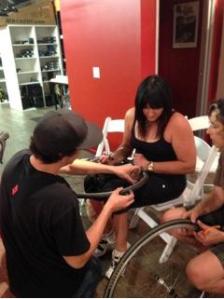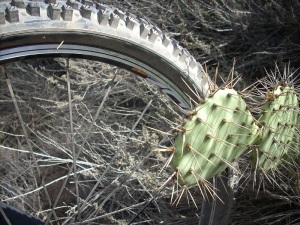![]() Welcome to Keven Lee’s Mechanical Skills Clinic, courtesy of Holland Cycles. This is the second of a series based on his clinic for WWSD riders on May 14, 2014. We started off with a pre-ride bike check…This is on how to remove and install wheels to the bike frame.
Welcome to Keven Lee’s Mechanical Skills Clinic, courtesy of Holland Cycles. This is the second of a series based on his clinic for WWSD riders on May 14, 2014. We started off with a pre-ride bike check…This is on how to remove and install wheels to the bike frame.
Removing the Wheel (Procedure varies Front to Rear)
Front Wheel
1. Open the brake cable quick release (usually a quick release you flip up with your thumb).
2. Open the quick release (QR) lever on the wheel, and unthread the nut on other side of QR. The nut only needs to be unthreaded far enough to clear the tabs on the bottom of the fork. NOT completely off!
3. Simply lift the bike holding the handlebar or stem and the wheel should come free from the fork. Sometimes you may need to finesse the tire through the brake pads.
Rear Wheel
1. Start with your chain on the highest gear (smallest cog).
2. Open the brake cable quick release.
3. Open the QR lever on the wheel. Note : The rear wheel does not require the nut on the other side of the quick release to be unthreaded.
4. In a simultaneous motion:
a) Lift the bicycle by the saddle or top tube
b) Push the derailleur cage, and rotate the derailleur out of the way from the cassette.
c) The wheel should fall freely away from the frame. Note: Sometimes the wheel may require a little finessing the tire through the brake pads.
Now for putting them back on…
Installing the Wheels (Procedure varies Front to Rear)
Front Wheel
1. Lift the bike by the handlebar or stem.
2. The wheel should go evenly into the fork dropouts.
3. Make sure both sides of the fork go onto the axle properly. You may need to finesse the tire through the brake pads.
4. Check that the wheel is centered in the fork.
5. Hold the wheel’s quick release (QR) lever with one hand, and tighten the nut on the other side a bit tighter.
6. Find the “sweet spot” between tightening the nut and being able to close the QR lever. It should be tight to close, but not too tight. The nut needs to be threaded on approximately 95%.
– Closing the QR lever. In order to close the QR, the nut needs to be tight enough to create tension on the QR lever when it is closed. Note: The QR lever should leave a light discoloration / impression in your hand while closing it.
7. Re-check that the wheel is centered in the fork.
8. Close the brake cable quick release lever (restore to its normal position).
9. Squeeze the brake to make sure the pads are not pushing the wheel to one side. If so, the wheel is either not centered, or the brake pads are not centered properly (advanced topic).
Rear Wheel
1. Make sure the derailleur is in the highest gear position (smallest cog).
2. Make sure the brake cable quick release is in the open position.
3. Position the wheel in between the rear triangle.
4. Position the smallest cog directly under the upper derailleur pulley. Make sure the chain is seated properly on the teeth of the cassette e.g. around both sides of the cassette.
5. In a simultaneous motion:
– Push down on the bicycle by the seat or top tube.
– Push the derailleur cage, and rotate the derailleur.
– The wheel should fall right into position within the derailleur. The wheel should go evenly into the rear dropouts. Make sure both sides of the frame go onto the axle properly. You may need to finesse the tire through the brake pads.
6. Check that the wheel is centered in the frame.
7. Hold the QR Lever with one hand, and thread the nut tighter on the other side.
8. Find the “sweet spot” between nut and QR lever, and close the QR.
If you did not unthread the QR when the rear wheel was removed, you simply should be able to close the lever and have the QR at proper tension.
9. Re-check that the wheel is centered in the frame
10. Lift the bike by the seat or top tube, and pedal the crank a few revolutions with your hand.
– The chain should run smoothly after 3 or 4 crank revolutions.
– Shift the right shifter a few times (5 if it will let you), and then lift the bike and pedal the cranks a few more times. This will help you start off in an easier gear.
11. Re-Check that the wheel is centered in the frame.
12. Close the brake cable quick release (restore to previous position).
13. Squeeze the brakes. Check to see if the pads are pushing the wheel to one side. If so, the wheel is either not centered, or the brake is misaligned (advanced topic).
Next post: replacing the tube!









